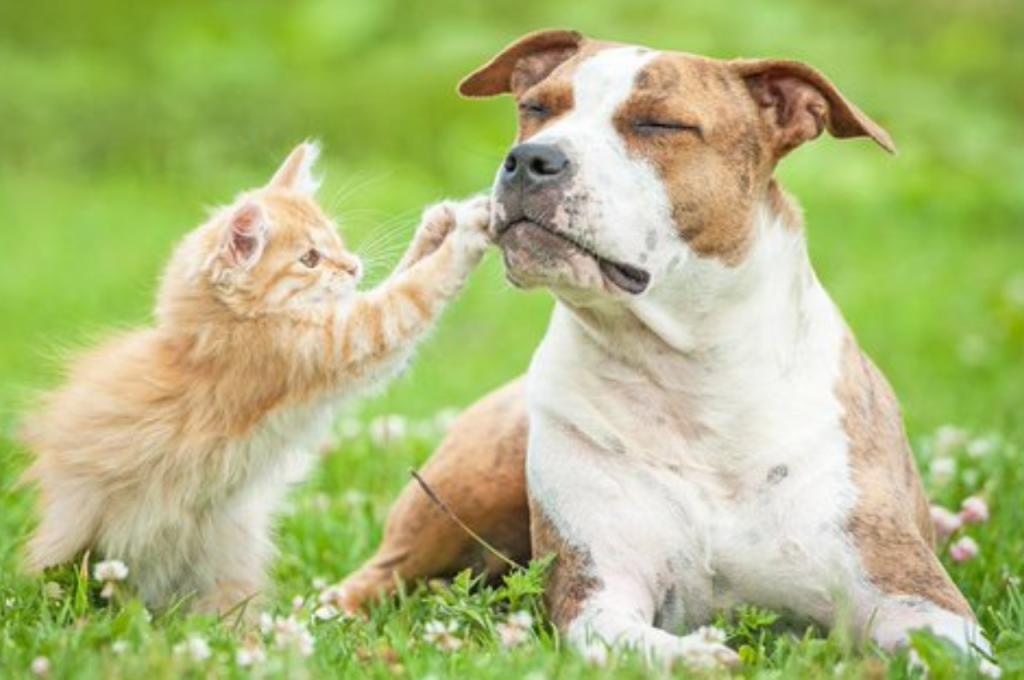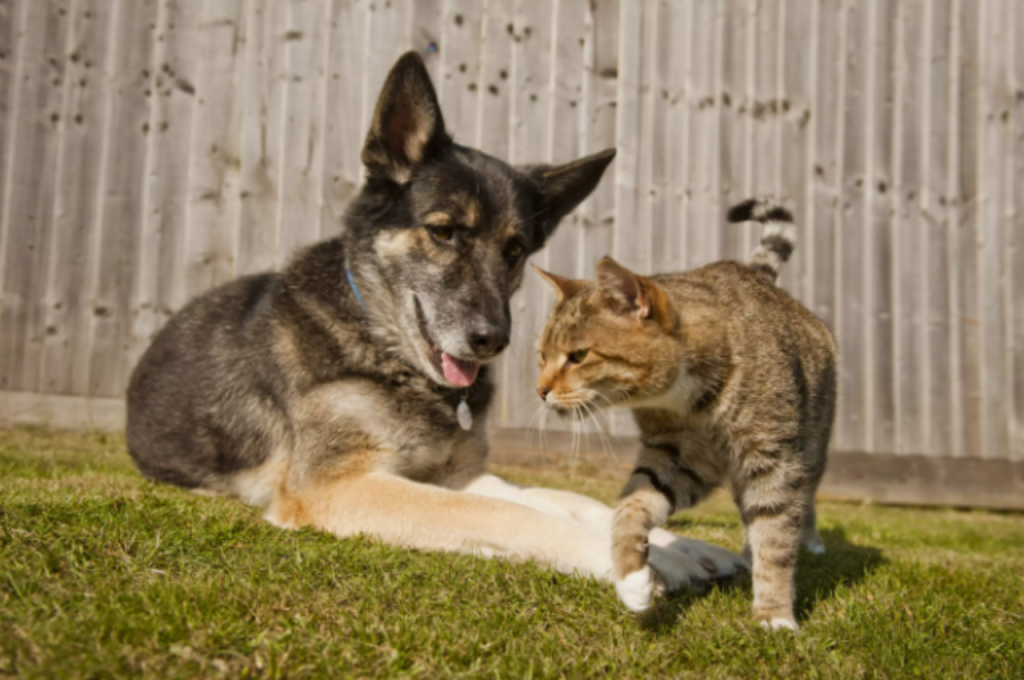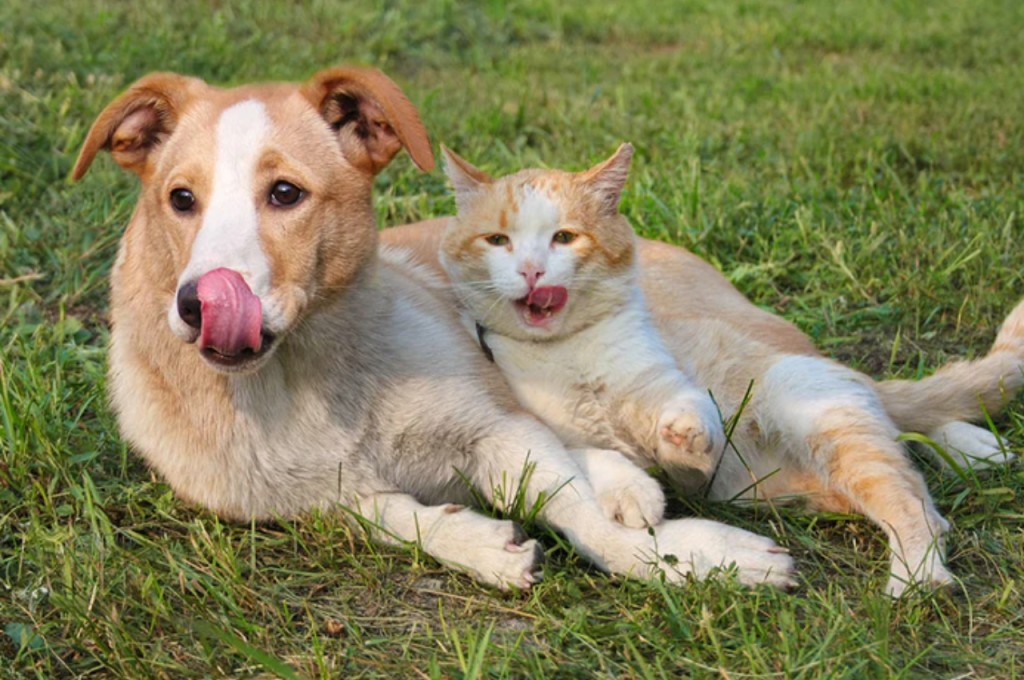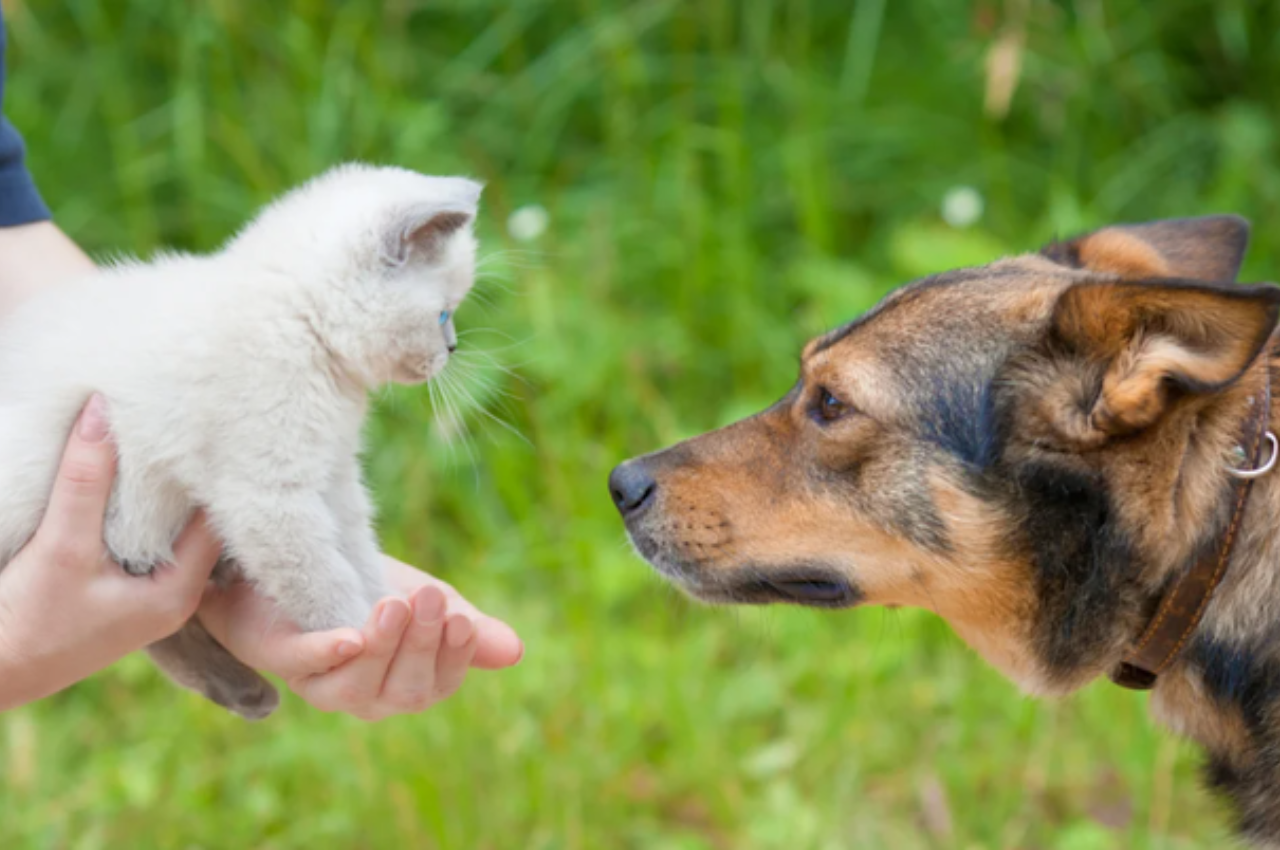To understand how to introduce a dog to a cat, start by keeping them in separate rooms to prevent direct contact. Gradually introduce their scents by having them sniff each other’s bedding or toys, allowing them to become familiar with each other’s presence indirectly.
After this, let them see each other through a baby gate or a cracked door, maintaining a safe barrier between them. Slowly increase their exposure to one another, closely monitoring their behavior for signs of stress or aggression.
Use positive reinforcement, such as treats and praise, to create a calm and positive association. Patience and careful supervision are essential for ensuring a smooth introduction and fostering a harmonious relationship between your dog and cat.
The Great Introduction
Introducing a dog to a cat can be a tricky situation, but with proper preparation and understanding of animal instincts, it can be a smooth process. The first meeting between a dog and a cat is crucial, and it’s important to take the time to make it a positive experience for both animals. The following steps will guide you through the process of introducing a dog to a cat.

Preparation Is Key
Preparation is essential when introducing a dog to a cat. Before the first meeting, ensure that both animals are up-to-date on their vaccinations and are in good health. Make sure the dog is on a leash and the cat is in a separate room, and have a baby gate handy to separate the animals if needed. It’s also important to have treats and toys on hand to reward good behavior and distract the animals if necessary.
Understanding Animal Instincts
Understanding animal instincts is crucial when introducing a dog to a cat. Dogs are natural predators and may see a cat as prey, while cats are often fearful of dogs and may view them as a threat. It’s important to supervise the first meeting closely and look for signs of aggression or fear from either animal. If either animal shows signs of aggression or fear, separate them immediately and try again later.
When introducing a dog to a cat, it’s important to take the process slow and let the animals get used to each other gradually. Start by allowing them to sniff each other through a closed door or gate, then progress to supervised face-to-face meetings with the animals on opposite sides of the room. Gradually decrease the distance between the animals until they can be in the same room together.
By following these steps and taking the time to properly introduce a dog to a cat, you can help ensure a positive relationship between the two animals.
Setting The Stage for Success
Prepare for success by gradually introducing your dog to your cat. Start by keeping them in separate rooms, allowing them to become familiar with each other’s scent. Then, use a controlled introduction to ensure a positive first interaction.
Introducing a dog to a cat can be a delicate process that requires careful preparation and consideration. By setting the stage for success, you can help create a harmonious environment for both your furry friends. This involves creating a safe space and promoting familiarity through scent. Let’s explore these steps in more detail.
Creating a Safe Space
One of the first steps in introducing a dog to a cat is to create a safe space where both animals can feel secure. This can be done by designating separate areas for each pet, at least initially. Consider using baby gates or pet barriers to create physical boundaries. This allows them to see and smell each other without direct contact, reducing the potential for conflict or stress.
In the dog’s designated area, provide comfortable bedding, toys, and water. Similarly, in the cat’s area, ensure there are hiding spots, a litter box, and scratching posts. By providing these individual spaces, you are giving each pet a sense of ownership and security.
Familiarity Through Scent
To help your dog and cat become accustomed to each other’s presence, it is essential to promote familiarity through scent. Animals rely heavily on their sense of smell, so exchanging scents can facilitate a smoother introduction. Start by swapping bedding or blankets between the dog and cat areas. This allows them to become familiar with each other’s scent without direct interaction. Additionally, you can rub a cloth or towel on one pet and place it near the other, gradually moving it closer over time.
This gradual exposure helps both animals become accustomed to each other’s scent, reducing the likelihood of aggression or fear. Another effective technique is to use pheromone sprays or diffusers. These products mimic natural calming signals, helping to create a relaxed atmosphere for both pets. Placing these in the designated areas can further promote a positive association between the dog and the cat.
In conclusion, setting the stage for success when introducing a dog to a cat involves creating a safe space and promoting familiarity through scent. By following these steps, you can increase the chances of a successful and harmonious relationship between your beloved pets. Remember, patience and gradual introductions are key, allowing both animals to adjust and form positive associations with each other’s presence.
First Impressions Matter
Introducing a dog to a cat is crucial for a harmonious pet household. Start by keeping them in separate rooms and gradually introduce their scents through swapping bedding. Slowly allow visual contact and always supervise their interactions, using positive reinforcement to create a calm and friendly atmosphere.
Introducing a dog to a cat can be a tricky and stressful process, but with the right approach, it can be a successful one. The first impression between your pets is crucial, as it sets the tone for future interactions. It’s important to take things slowly and introduce your pets in a controlled environment to avoid any potential conflicts. Here are some tips for making a positive first impression between your dog and cat.
Controlled First Encounter
The first step in introducing your dog to your cat is to create a controlled environment. Choose a neutral location where neither pet has established territory, and keep them both on a leash or in a carrier. Allow them to sniff each other from a distance, rewarding them with treats and praise for calm behavior. Gradually move them closer together, but always supervise the interaction and be ready to intervene if necessary.
Reading Body Language
It’s important to pay attention to your pets’ body language during their first encounter. Signs of aggression in dogs include growling, baring teeth, and stiff body posture. Cats may hiss, arch their backs, or flatten their ears. If you notice any of these signs, separate your pets and try again later. Positive body language includes wagging tails, relaxed body posture, and sniffing without aggression.

Creating a Positive Association
To help your pets form a positive association with each other, use treats and praise to reward good behavior. For example, if your dog remains calm and doesn’t show signs of aggression, give them a treat and praise them. This will help them associate good behavior with positive reinforcement. Over time, your pets will learn to tolerate each other and may even form a bond. Introducing a dog to a cat takes patience and a gentle approach.
With these tips, you can help your pets form a positive relationship and live together peacefully. Remember, the first impression is crucial, so take your time and create a controlled environment for the initial meeting.
The Power of Positive Associations
Learning how to introduce a dog to a cat involves the power of positive associations. Use treats, praise, and gentle interactions to create a calm and friendly atmosphere. Gradually increase their time together, ensuring each experience is positive, which helps build a harmonious relationship between your dog and cat.
Reward-based Interactions
Rewards like treats help create positive associations between the dog and the cat, making them feel more comfortable and less stressed around each other, ultimately fostering a harmonious relationship.
Consistency and Patience
Consistency and patience are essential when learning how to introduce a dog to a cat. Start with short, supervised interactions and gradually increase their duration as both pets become more comfortable. Consistent, patient interactions, combined with positive reinforcement like treats and praise, help build trust and a harmonious relationship between your dog and cat, ensuring successful introductions.
When Things Don’t Go As Planned
Introducing a dog to a cat requires patience, supervision, and gradual introductions in a safe environment. Start by keeping them separated and allowing them to get used to each other’s scent before progressing to visual interactions. Use positive reinforcement and reward good behavior to create a harmonious relationship between your furry companions.
Handling Aggression
If your dog and cat are displaying aggressive behavior towards each other, it’s crucial to address the situation promptly. Start by creating separate spaces for the dog and cat, ensuring they can’t physically interact. Use baby gates or closed doors to keep them apart, and provide each pet with its own food, water, and litter box.
Professional Help and Advice
Seeking professional help from a certified animal behaviorist or trainer can provide valuable insights and techniques for managing aggression between your dog and cat. They can assess the situation and develop a customized behavior modification plan to address the underlying issues.
Additionally, consulting with your veterinarian is essential to rule out any underlying health concerns that may be contributing to the aggression.
The Slow and Steady Approach
When introducing a dog to a cat, it’s essential to take a slow and steady approach. Rushing the process can lead to stress and anxiety for both pets. By gradually acclimating them to each other’s presence, you can help foster a positive relationship between your dog and cat.
Gradual Exposure
Gradual exposure is key when introducing a dog to a cat. Start by keeping them separated in different rooms, allowing them to become familiar with each other’s scent. Over time, begin swapping their bedding or blankets so they can further acclimate to each other’s smell. This gradual exposure helps reduce the likelihood of a negative reaction when they finally meet face to face.
The Role of Play
The role of play in introducing a dog to a cat should not be underestimated. Engaging your pets in separate play sessions near a closed door can help them associate positive experiences with each other’s presence. This can also help to distract them from potential feelings of fear or aggression.
When they are comfortable, allow them to interact in controlled, supervised environments, always rewarding calm and positive behavior.
Maintaining a Harmonious Household
Introducing a dog to a cat can be a delicate process, but with patience and the right approach, it’s possible to create a peaceful coexistence between the two pets. By following a few key strategies, you can ensure a smooth transition and maintain a harmonious household.
Daily Routines and Boundaries
Establishing daily routines and clear boundaries is essential when introducing a dog to a cat. Creating designated areas for each pet can help minimize potential conflicts. Set up separate feeding and sleeping areas for the dog and the cat to give them their own space. Additionally, maintain consistent meal and play schedules to help both pets feel secure and establish a sense of order.
Continuous Observation
Continuous observation is crucial during the initial stages of introducing a dog to a cat. Monitor their interactions closely to ensure the safety of both pets. Look for signs of distress or discomfort, and be prepared to intervene if necessary. Gradually increase the duration of their supervised interactions to allow them to become familiar with each other in a controlled environment.
Success Stories and Tips
Introducing a new pet to your family can be daunting, particularly when it comes to dogs and cats. However, with the right approach, it’s possible to ensure a smooth transition. Follow these tips to introduce a dog to a cat and help them become best friends.

Real-life Examples
Real-life examples of how to introduce a dog to a cat highlight the importance of gradual exposure and positive reinforcement. For instance, one pet owner started with scent swapping and short, supervised meetings, gradually increasing interaction time. Over weeks, the pets became comfortable with each other, demonstrating that patience, consistency, and rewards like treats can lead to a harmonious relationship.
Common Mistakes to Avoid
When learning how to introduce a dog to a cat, avoid common mistakes like rushing the process, forcing interactions, or neglecting to supervise. Don’t ignore signs of stress or aggression, and avoid using punishment. Gradual exposure, patience, and positive reinforcement are key to building a harmonious relationship and ensuring successful introductions between your dog and cat.
Conclusion
Introducing a dog to a cat requires patience and gradual steps. Create positive interactions between them. Supervise their initial meetings. Provide safe spaces for both pets. Consistency and positive reinforcement are key. With time and proper introductions, they can become great companions.
